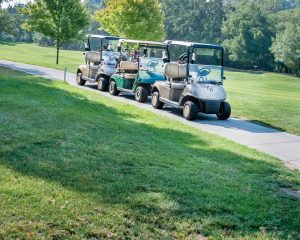How far a golf ball travels depends on nine factors:
- Swing speed
- Clubface vertical angle (loft) at impact
- Clubface horizontal angle at impact
- Swing path
- Contact point of ball on clubface
- Club and ball design, construction and condition
- Course conditions and topography
- Elevation
- Weather conditions
So, you’re asking yourself, “How far should I hit my golf clubs?” Obviously, the answer is, “It depends,” but that answer doesn’t really do anyone any good. What we look at instead are averages.
For this guide to golf club distance, we’re going to focus on the average distances by club for both amateur golfers and PGA Tour professionals. Just know that in both groups there is a ton of variability.
Before we get into the numbers, golfers are looking for a guide to golf club distance for at least one of three main reasons:
- They’re worried that you are generally not hitting the ball as far as they should
- They’re afraid the distance of one or more of their clubs is out of whack
- They know they hit longer than most golfers and are wanting to enjoy a little flex
If either of the first two is the case for you, hopefully, you’ll get some answers. If are looking to enjoy affirmation of what you already know, that you hit bombs, then we’re here to give you what you want.
If you are here to determine if you are hitting far enough, you may have read elsewhere that you should play to whatever distance you are hitting. While this is true in some regards, unless you are playing in a tournament this weekend, you really should focus on increasing your distance. It can be a huge advantage, especially with the driver.
If you are here to figure out certain clubs then it is important to understand that there is such a thing as hitting too far with certain clubs as it relates to other clubs in the bag. One example would be if you are hitting your 7-iron 160 and your 8-iron 158. It isn’t doing you any good to have both clubs in your bag because they both cover basically the same distance. This could happen for a number of reasons but finding your yardages and checking the gapping is absolutely critical to improving your score.
In addition to average distances, we’ll go over some ways to gain distance. We’ll also cover factors that can positively or negatively affect distance and how to account for these when selecting a club. Rember, the yardages below are simply averages of amateur golfers and tour golfers so don’t get too hung up on them.
We believe the most helpful takeaway is the printable distance chart. Print it out and carry a copy of it in your bag. You’ll be surprised when you start tracking your distances if you haven’t done it before. Really seeing how far you are hitting clubs can be a huge difference-maker in lowering your score!
How Far Should I Hit My Driver?
Phil Mickelson dubbed 2021 the year of “hitting high, nasty, straight bombs.” In 2020 “Lefty” averaged 301.5 yds per drive and, at age 51, is averaged 301.8 in 2021. Phil Mickelson hits bombs. Phil even owns the trademark for “Hit Bombs” because he knows the advantage of hitting your driver as long as possible.

Bryson DeChambeau is another golfer whose focus on long drives has recently earned him some press. DeChambeau is the first PGA Tour player in 20 years to participate in a long drive competition, finishing in the top 8. This competition came just a week after hitting one of the longest drives in Ryder Cup history: 417 yds.
Hitting your driver long off the tee is a huge advantage in golf. Take that shot in the Ryder Cup by DeChambeau for example. His drive put his second shot 72 yards from the pin on a 581 yd par 5. He got up and down for Eagle to win the hole easily. The picture of the drives of the players shows how much of an advantage his drive gave him on that hole.
**PICTURE OF DECHAMBEAU DRIVE DISTANCE**

Average golfers obviously aren’t going to hit 400+ yd drives so what can you expect? A good, achievable target, if you’re willing to work for it, is 250 yds for men and 200 yds for women. There are plenty of swing aids and exercises you can use to improve swing speed. Swing speed directly correlates with driving distance so anything you can do to improve your swing speed will lead to distance off the tee.
Driving it far is all well and good but what about driving accuracy? Don’t you sacrifice some of that if you’re swinging out of your shoes? Actually, a recent study shows the further you drive the less accuracy matters, assuming accuracy remains within reason. So you can go ahead and swing away – unless you can’t keep it in bounds!
How Far Should I Hit My Woods
Fairway woods are a much more fickle club when it comes to distance. These are clubs that you’ll tee up in the tee box but would hit off the turf in the fairway. Just as you won’t get as much distance taking a driver off the deck, your fairway woods will be shorter in the fairway.
That being said, fairway woods typically come in 3-wood, 5-wood, and 7-wood. The difference in these is the loft and club head size. The 3-wood averages around 220 for men and 160 for women. A 5-wood averages about 200 for men and 140 for women and a 7-wood averages about 185 for men and 130 for women.
Again, this is all predicated on swing speed so if you aren’t hitting these averages or would like to add some additional yardages all it takes is some speed training to boost your numbers.
How far should I hit my hybrids
A 3-hybrid typically will be carried in place of a 5 wood or vice versa. There is roughly a 10-15 yard gap between clubs moving down. So if you hit your 3-hybrid 200 yds, you would expect a 4-hybrid would go 190, a 5-hybrid would go 180, and so on. These clubs are intended to replace irons and manufacturers try to mimic the distances as closely as possible.
One advantage of hybrids is the ability to connect with the ball more consistently due to the clubhead design. Having more weight and lowering the center of gravity makes it easier for slower-swinging players to get the club around and make solid contact with the ball. As a result, many golfers feel that a hybrid offers an increase in distance over the correlating iron. This is probably more due to the ability to make more consistent contact than to the actual loft/potential distance.
I currently play a bag of Cleveland Golf Altitude 588 irons which is essentially just a full set of hybrids 5-PW. I initially got the clubs as a test because I found a used set for next to nothing. After playing them side-by-side with my forged irons for several weeks, I decided I liked the forgiveness and have made the switch. Not the sexiest decision but it dropped my score a few strokes so it has been well worth it!
How far should I hit my irons
Not to keep beating a dead horse but everyone will hit their irons at different distances. Like hybrids, it is common to have a 10-15 yard gap between irons. Some people carry a 2 iron which generally has a distance similar to a 5-wood or a 3-hybrid. It is usually carried as a driving iron and often only for specific courses. For most people, iron sets go from 3-PW or GW.
Some golfers like the consistency of the included pitching and/or gap wedge whereas others like to have a separate set of wedges to keep their game consistent at those shorter distances. It’s been my experience that the included wedges have kept with the trend in irons becoming increasingly delofted. If you are going to use the included pitching or gap wedge, you can generally expect the yardages to be more in line with the other irons in your bag. For instance, expect a 10-yard gap from your 9-iron to your pitching wedge and a similar gap from your pitching to gap wedge. Otherwise, iron distances will be similar to the hybrid distances above.
How Far Should I Hit My Wedges
Wedge distances are challenging simply because it depends so much on what loft wedge you are using. If you are having difficulty selecting wedges, check out our guide on picking out the wedges for your bag.
Typically you want your wedges to be spaced similarly to your irons, 10 yards between wedges which, based on the average 9 iron distance, would give you something along the lines of
- PW – 110
- GW – 100
- SW – 90
- LW – 80
But because so much of the distance depends on loft and swing speed, you’ll need to reference the chart below to see what average distances are based on what loft wedges you carry in your bag.
Golf Club Distance Chart
And now, the reason you probably clicked into this article — the comprehensive golf club distance chart! Here is the best chart we could come up with for presenting you with short, medium, and long hitters for each club based on swing speed.
If you are interested in finding out your own yardages (which we would highly recommend), we have created a printable golf club distance chart for you to track. Look to record four good hits with each of the 13 clubs in your bag. The average of those four shots should give you a reasonable estimate of your typical current distance with each club.
We say good hits because you shouldn’t count duffs or shanks in your average. You also don’t want to count the drive that took five big bounces down the cart path and ended up 320 out! The goal is to get the distance of what you would consider four typical, but solid hits and then average those to get an idea of your reasonably expected yardage.
Here is a copy of mine that I filled out after hitting a local range with a shot tracer a couple of weeks ago. As you can see, my spacing is pretty good. The biggest problem is with my wedges (for more about my wedge selection, read my article on what wedges you need). The only other surprising gap is between my 6 and 7-hybrids. Nearly 20 yards is a relatively large gap, something I’ll examine moving forward.
How to increase swing speed?
This will not be a comprehensive guide as there is way too much to cover on this topic, but I’ll provide some basics.
Strengthen your core
It seems like this is the first advice you always receive when you are looking to improve in an athletic pursuit. It is essential in golf because the stronger your core, the faster you are able to turn your body and move the club head through the hitting area. As I was finding my club distances, I hit about 200 balls at the range, way more than I’ve ever hit at one time in my life. The next day I woke up, and my left forearm was sore, as expected, but what surprised me was that my core was also quite painful. Improving strength here is a simple way to increase your swing speed. Planks, squats, pull-ups, rowing, and push-ups are all great exercises to strengthen muscles that affect your swing.
Increase flexibility
This is similar to increasing your core strength, but you are increasing club head speed by increasing the distance the clubhead can travel. The farther the club head can travel from the top of your backswing to the point of contact, the more time it has to increase speed. Yoga and dynamic stretching are great ways to increase your flexibility.
Swing Speed Training Aids
There are nearly countless swing training aids designed to help increase swing speed. We will eventually get around to writing a full review of many of them. In the meantime, one way that has been shown to increase speed is called overspeed training. It involves swinging a lighter club than your driver as fast as possible, moving up in weight until you are swinging a club that is heavier than your driver. The process creates muscle memory that can transfer that speed to your driver.
Another method is using an aerodynamic resistance trainer. The resistance helps you develop the muscles that will help you increase your speed.
What else affects distance?
Weather and elevation
Both elevation and weather will affect golf club distance. Higher elevation has thinner air, so balls will normally travel further. All other things being equal, you’ll find less distance when playing a course near seal level in San Diego or Miami than you will playing a round in Denver or Salt Lake.
Colder temperatures also impact ball compression and ball flight leading to shorter distance. Make sure when you are measuring your distance that the day is neither too hot nor too cold. Wet weather either during or before your round also will adversely affect ball flight and roll following a shot. Just be careful measuring distances in atypical weather or course conditions, as the goal is to get a reasonable estimate of your average length under typical conditions.
That said, understanding how weather and elevation affect your ball flight will help you adapt your distance from your average. Studies show that every 10-degree drop in temperature costs you 2 yards of distance carry. For instance, that means that if you usually play in 80-degree weather, when you play at 60 degrees, you probably need to club up half a club. Understanding the impact weather has on distance should inform your club selection. Knowing this can potentially shave a shot or two off your score during a round played in inclement weather.
Golf Ball Effect on Distance
Golf ball compression rating and cover material affect the distance you can hit.
Compression
Golf balls are generally categorized as low, medium, and high compression golf balls, depending on how soft their cores are. Compression of the golf ball affects how the ball spins and how far it will travel. In order to maximize distance, a golfer needs to compress the ball. Generally, swing speed should correlate to the compression rating. That is, low swing speeds generally benefit from low compression balls while high swing speeds generally benefit from higher compression balls.
The reason for this is that golf is a game of distance and direction. For the person with a slow swing speed (less than 80 MPH), distance is king. This is due not only to the advantages of distance discussed previously but also because less swing speed is created by the swing path so the impact of mishits is less. Said another way, the control of the ball should be less important than maximizing distance to a player with a slow swing speed.
For players with a mid-range swing speed (between 80 to 100 MPH), the considerations that go into picking the right golf ball are a bit more complicated. This is because there remains considerable appeal to maximizing distance, but the swing speed paired with a low compression ball can result in exaggeration of mishits. Each player will need to weigh the power-control balance for themselves, but matching the ball to a player’s specific focus can help improve results.
For players with high swing speeds (over 100 MPH), distance is going to happen – hit the ball going that fast, and you have yourself a bomb. For such golfers, the risk of a significant mishit is ever-present if the swing speed is not accompanied by good mechanics. The impact on shot direction from swing errors is exaggerated at higher swing speeds, arguing for a higher compression ball.
Of course, there are no hard and fast rules. Players need to find a ball that fits their game and their wallet, but as a general rule, compression should follow swing speed.
One notable exception to this general rule is when you are playing in the cold. In the cold, golf balls feel harder than they do at warmer temperatures. When playing an arctic round, consider stepping down in the compression of the golf ball you select. Your hands will thank you.
Cover Material
There are two common materials used for golf ball covers: Urethane and Ionomer.
Urethane is used in high-end golf balls because it is a softer material providing better feel and spin. It is less durable, but the added control of the ball is why golfers choose urethane over ionomer.
Ionomer is a type of polymer plastic of which surlyn is the most common. These more durable balls offer less feel but typically go further because they spin less than urethane.
Before we leave the topic of golf balls, let’s be clear. The golf ball you play makes some difference, but a different ball will not make that big a difference regardless of skill level. The difference is one in the margins, not a big difference-maker. If you really want to elevate your game, don’t fool yourself into thinking a more pricey ball is the key. Get the rest of your game right, and then worry about the ball you’re playing, not the other way around.
Once You Know Your Distance, What’s Next?
So now you’ve tracked your distance and know how you stack up to average players. You know how to account for weather and elevation on your club selection, and you even have a few tips on how to increase your distance. So, what’s next?
Now is a great time to take a closer look at what clubs are in your bag. Matching the golf clubs you carry with your game is a smart next step. The key to golf is hitting the ball the right distance and in the right direction. Having the tools that make that as likely as possible is a good idea. Take a look at our post “What Clubs Should I Have in My Bag”
We’d love to hear your thoughts on our thoughts.






